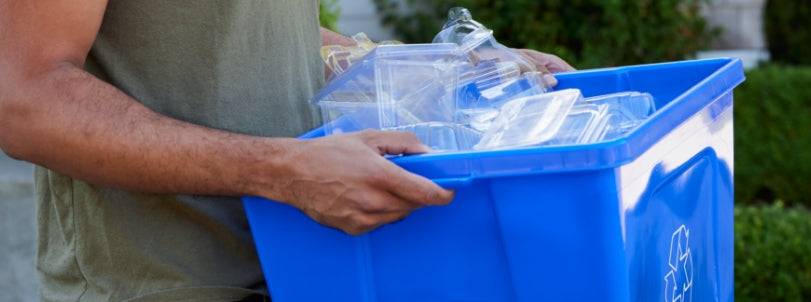
Compostable vs. Recyclable vs. Biodegradable:
What’s the Difference?
When it comes to sustainability, terms like compostable, recyclable, and biodegradable often get tossed around like they mean the same thing. But in reality—especially in North America’s complex waste management systems—these terms mean very different things. Understanding what sets them apart can help businesses and consumers make smarter, more eco-friendly choices. Let’s break it down. 👇
Recyclable Packaging: What You Need to Know
What does “recyclable” actually mean?
Recyclable materials are those that can be collected, processed, and turned into new products. Commonly recycled items include glass, aluminum, and certain types of plastic. But here’s the catch: just because something can be recycled doesn’t mean it will be.
In the world of plastics, the most commonly recycled items are PET #1 plastic bottles and HDPE #2 milk jugs. Why? Because these are the ones that actually hold value in the recycling market.
The Reality of Recycling in North America
Despite how much we want recycling to work, the numbers tell a different story. In 2018, the U.S. produced over 35 million tons of plastic waste—yet less than 15% of it was actually recycled. Most of that came from beverage bottles. Non-bottle plastic packaging? Only about 8% gets recycled.
That means a lot of those food containers you’re carefully rinsing and tossing in the blue bin? They’re not getting recycled. Here’s why:
- It’s a Business: Recycling is a for-profit industry. Only materials with real market value get prioritized.
- Contamination: Food residue or mixing the wrong materials together can ruin entire batches.
- Infrastructure Gaps: Not every facility is equipped to handle all materials. This leads to regional inconsistencies in what’s accepted.
Tips for Making Recycling Work
- Stick to the basics: Materials like PET and HDPE plastics are your safest bets. Avoid black plastics—they often can’t be detected by sorting machines.
- Rinse it out: Clean containers = higher chances they’ll actually get recycled.
- Know your local rules: What works in one city may be a no-go in another. Look up your local recycling guidelines—and see if there are specialty programs for trickier items like clamshells or plastic film.
Compostable Packaging: Breaking It Down
What does “compostable” mean?
Compostable packaging is designed to break down into nutrient-rich soil—usually within 180 days—under the right conditions. That’s typically in an industrial composting facility, not your backyard bin.
Look for certifications like BPI (Biodegradable Products Institute). If it’s BPI-certified, you can trust it’s passed strict testing and will break down safely without leaving behind toxins.
Compostable vs. Biodegradable vs. Oxo-Degradable
These terms get mixed up a lot, but they’re not the same thing:
- Compostable: Breaks down into safe, non-toxic components that enrich soil—under the right conditions and within a set timeframe.
- Biodegradable: Vague and unregulated. Might break down... eventually.
- Oxo-degradable: Breaks into tiny fragments (aka microplastics) but never fully decomposes. Not great.
Challenges in the Current System
In North America, the big challenge with compostables is access. Industrial composting facilities aren’t available everywhere, and if compostable packaging ends up in landfill—it won’t break down properly.
That said, there are great opportunities in places with closed-loop systems like stadiums, hotels, or campuses. In those environments, compostables can truly shine. 🌟
How to Make Compostable Work
- Look for certification: BPI-certified items are your best bet.
- Help customers out: Clear disposal instructions go a long way.
- Support infrastructure growth: Push for more composting facilities so these materials can actually be processed the way they’re meant to.

Biodegradable Packaging: A Closer Look
What does “biodegradable” mean?
Technically, biodegradable packaging will break down into natural elements... eventually. But here’s the problem: there’s no regulation around how long that takes, or what’s left behind.
That’s why California and some other regions have cracked down on using the term “biodegradable” in packaging—it’s often more confusing than helpful.
Why It’s Tricky
- No clear timeline: Could take months... or decades.
- May leave behind microplastics: Not exactly earth-friendly.
- Greenwashing potential: With no standards in place, some brands use “biodegradable” as a marketing tool, even if the environmental benefits are minimal.
What You Can Do
* Stick with certified compostable or recyclable: These options have clear disposal paths.
- Ask questions: Look for brands that are transparent about their materials and end-of-life processes.
- Keep learning: The world of sustainable packaging is evolving. Stay informed—and push for clearer labeling standards. 📚
Final Thoughts: Smart Choices for a Sustainable Future
Understanding the differences between compostable, recyclable, and biodegradable packaging helps us all make better choices—for the planet and for our communities.
Right now, the system isn’t perfect. Recycling has its limitations, and composting infrastructure still needs to catch up. But here’s the good news:
- Certified compostable items won’t leach harmful chemicals, even if they end up in landfill.
- Choosing widely recyclable or compostable packaging reduces waste and contamination.
- By staying informed and supporting smarter systems, we can all help create a more circular economy
✨ Looking for sustainable packaging solutions that actually work in today’s waste infrastructure? Let’s chat. We’re here to help you find options that align with your values—and the realities on the ground.
